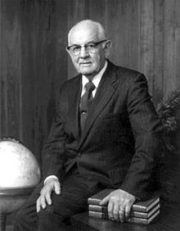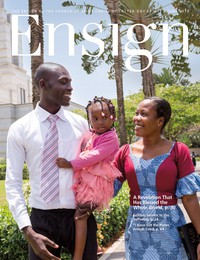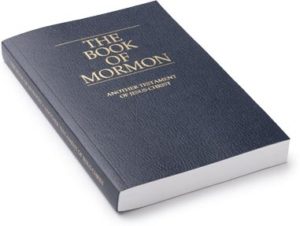A Meeting and a Revelation

Spencer W Kimball
None among us were unhappy about this development, but we knew this was not just a much welcome change but a complete about face on a long-established Mormon teaching. We had sat in all-white priesthood classes learning the history of the ban, perhaps feeling uncomfortable, but faithfully believing this was God’s will. Church leaders had confidently declared what we had just been told would not happen, ‘not while time endures.’ We were familiar with the words of Mormon leaders such as Brigham Young, and Joseph Fielding Smith:
“You see some classes of the human family that are black, uncouth, uncomely, disagreeable and low in their habits, wild, and seemingly deprived of nearly all the blessings of the intelligence that is generally bestowed upon mankind…and the Lord has put a mark upon him, which is the flat nose and the black skin.” (Brigham Young, Journal of Discourses, vol.7pp.290-91)
“There is a reason why one man is born black and with other disadvantages, while another is born white with great advantages. The reason is that we once had an estate before we came here, and were obedient, more or less, to the laws that were given us there. Those who were faithful in all things there received greater blessings here, and those who were not faithful received less.” (Joseph Fielding Smith, Doctrines of Salvation, vol.1, p.61)
From Joseph Smith, who said, ‘I can say, the curse is not yet taken off the sons of Canaan, neither will it be until it is affected by as great a power as caused it to come’. (History of the Church, vol2, p.438) John Taylor, the 3rd President of the church, who said that the Negro is the representative of Lucifer on the earth, and Joseph Fielding Smith, the church’s 10th President who, in 1966, said, ‘It would be a serious error for a white person to marry a Negro, for the Lord forbade it’. (Letter to Morris L Reynolds, 9 May, 1966)
Founded on this clear and emphatic teaching from 10 generations of Mormon leaders, the LDS writer John L Lund stipulated in 1967 two conditions that were to be met before Negroes could receive the priesthood:
‘The first requirement relates to time. The Negroes will not be allowed to hold the priesthood during mortality, in fact, not until after the resurrection of all of Adam’s children…The last of Adam’s children will not be resurrected until the end of the millennium. Therefore, the Negroes will not receive the Priesthood until after that time.
The second major stipulation is that…Abel marry, and then be resurrected, and ultimately exalted in the highest degree of the Celestial Kingdom so that he can have a continuation of his seed. It will then be necessary for Abel to create an earth for his spirit children to come to an experience of mortality. These children will have to be ‘redeemed’ or resurrected. After the resurrection or redemption of Abel’s seed, Cain’s descendants, the Negroes, will then be allowed to possess the Priesthood.’ (The Church and the Negro, 1967, pp.45-49 emphasis mine)
Whatever we think of Lund, and he has had his issues, he is merely reflecting long established LDS doctrine.
Unlike the current generation of Mormons, we knew all this and, welcome as this change was, we wondered how church leaders were going to justify such a contradiction. How were they to square that circle? How were we?
Denial and Celebration
These days, of course, the Mormon Church is in full denial, laying the blame at the door of that ‘racist’ LDS prophet, Brigham Young. Of course, this finds faithful Mormons on the horns of a dilemma. On one hand, they cannot bring themselves to recognise the curse and ban as official doctrine, on the other it hardly seems plausible, in light of fundamental LDS claims of exceptionalism, to admit Mormon leaders, ‘taught for commandments the doctrines of men, having a form of godliness, but denying the power thereof.’ (cf Joseph Smith: History, 1:19)
The current generation of church members are truly ignorant of their own church’s history on all kinds of issues. Such pressure has been brought to bear the church has published a series of essays to ‘explain’ some of the more controversial episodes and teachings from Mormon history.
Much of it my generation knew, and understood well enough their content. The publication of these essays has, however, opened up a whole world previously unknown to 21st century Mormons. How do they handle this new data on everything from men becoming gods, through polygamy, a mother in heaven, to the priesthood ban? What generations of LDS have done when faced with such challenges, what we did, follow the party line, repeat the received wisdom of the day. (2 Cor.4:4) Can they be blamed when their leaders have proved so disingenuous:
From the mid-1800s, the Church did not ordain men of black African descent to the priesthood or allow black men or women to participate in temple endowment or sealing ordinances. Over the years, a variety of theories were advanced to justify the restriction. Elder Jeffrey R. Holland of the Quorum of the Twelve Apostles has emphasised that those theories given in an attempt to explain the restrictions are “folklore” that must never be perpetuated: “However well-intended the explanations were, I think almost all of them were inadequate and/or wrong.… We simply do not know why that practice… was in place.” (Ensign, June 2018, p.32, emphasis mine)

Folklore? I don’t think so Mr Holland.
June 2018 is the fortieth anniversary of those events. The June 2018 Ensign magazine calls it ‘A revelation that has blessed the world.’ It has certainly ‘blessed’ the Mormon Church, as whole people groups previously unreachable for Mormonism because of a colour bar, now became a mission field or, as the Ensign spins it, ‘With the revelation came opportunities to expand missionary work, and membership flourished among many nations, kindreds, tongues, and people.’ I think I have just coined a new phrase, ‘Spinning a heinous.’
On June 1st this year the Mormon Church marked the occasion with an anniversary celebration entitled ‘Be One’ based on the Doctrine and Covenants (D&C) verse, ‘Be one; and if ye are not one ye are not mine.’ (D&C 38:27) Nobody seems to have pointed out that this verse has been there since a conference of the church in January 1831. Nor has it occurred to anyone this is no reason to celebrate, as though someone has come of age and gained the key of the door. What was once a clear, and clearly understood, Mormon doctrine, became an embarrassment blamed on the prejudices of the day, and of Brigham Young in particular, finally becoming a – cause for celebration?
Official Doctrine
One of the arguments put is that there is nothing ‘official’ about this teaching, it is not found in the canon of church scripture. It’s a familiar argument that gets the typical Mormon out of very tight spots because of the ill-thought-out statements of their ‘prophets.’ However, in Mormon scripture the position is very clearly taught in a rambling explanation of Ham’s unfortunate descendants through the king of Egypt:
‘Behold, Potiphar’s Hill was in the land of Ur, of Chaldea. And the Lord broke down the altar of Elkenah, and of the gods of the land, and utterly destroyed them, and smote the priest that he died; and there was great mourning in Chaldea, and also in the court of Pharaoh; which Pharaoh signifies king by royal blood.
Now this king of Egypt was a descendant from the loins of Ham, and was a partaker of the blood of the Canaanites by birth. From this descent sprang all the Egyptians, and thus the blood of the Canaanites was preserved in the land. The land of Egypt being first discovered by a woman, who was the daughter of Ham, and the daughter of Egyptus, which in the Chaldean signifies Egypt, which signifies that which is forbidden;
When this woman discovered the land it was under water, who afterward settled her sons in it; and thus, from Ham, sprang that race which preserved the curse in the land. Now the first government of Egypt was established by Pharaoh, the eldest son of Egyptus, the daughter of Ham, and it was after the manner of the government of Ham, which was patriarchal.
Pharaoh, being a righteous man, established his kingdom and judged his people wisely and justly all his days, seeking earnestly to imitate that order established by the fathers in the first generations, in the days of the first patriarchal reign, even in the reign of Adam, and also of Noah, his father, who blessed him with the blessings of the earth, and with the blessings of wisdom, but cursed him as pertaining to the Priesthood.
Now, Pharaoh being of that lineage by which he could not have the right of Priesthood, notwithstanding the Pharaohs would fain claim it from Noah, through Ham, therefore my father was led away by their idolatry;’ (Book of Abraham, vv.21-27, Pearl of Great Price (PoGP) Mormon teaching was much more recherché back in the day)
The Mark of Cain
The ‘Mark of Cain’ is thus clearly identified as an obvious barrier for the Canaanites to full participation in the blessings God has for His children. In other Mormon scripture we read the following:
‘And the Lord said unto me: Prophesy; and I prophesied, saying: Behold the people of Canaan, which are numerous, shall go forth in battle array against the people of Shum, and shall slay them that they shall utterly be destroyed; and the people of Canaan shall divide themselves in the land, and the land shall be barren and unfruitful, and none other people shall dwell there but the people of Canaan;
For behold, the Lord shall curse the land with much heat, and the barrenness thereof shall go forth forever; and there was a blackness came upon all the children of Canaan, that they were despised among all people.
And it came to pass that Enoch continued to call upon all the people, save it were the people of Canaan, to repent;’ (Moses, 7:7-8,12, PoGP)
The curse is a denial of blessings, especially priesthood but also denial even of hearing the gospel. This chimes with a statement from the late Bruce R McConkie:
‘Negroes in this life are denied the priesthood; under no circumstances can they hold this delegation of authority from the Almighty. The gospel message of salvation is not carried affirmatively to them…. Negroes are not equal with other races where the receipt of certain spiritual blessings are concerned…’ (Bruce R. McConkie, Mormon Doctrine, p. 477, 1958)
 The mark is a dark skin. A third official source shows a similar picture. In the Book of Mormon the Nephites are faithful in following God’s plan while their brothers, the Lamanites, rebel. The two groups separate and, in order to distinguish the faithful from the rebellious, the latter are marked with a dark skin.
The mark is a dark skin. A third official source shows a similar picture. In the Book of Mormon the Nephites are faithful in following God’s plan while their brothers, the Lamanites, rebel. The two groups separate and, in order to distinguish the faithful from the rebellious, the latter are marked with a dark skin.
‘And he had caused the cursing to come upon them, yea, even a sore cursing, because of their iniquity. For behold, they had hardened their hearts against him, that they had become like unto a flint; wherefore, as they were white, and exceedingly fair and delightsome, that they might not be enticing unto my people the Lord God did cause a skin of blackness to come upon them.
And thus saith the Lord God: I will cause that they shall be loathsome unto thy people, save they shall repent of their iniquities. And cursed shall be the seed of him that mixeth with their seed; for they shall be cursed even with the same cursing. And the Lord spake it, and it was done. And because of their cursing which was upon them they did become an idle people, full of mischief and subtlety, and did seek in the wilderness for beasts of prey.’ (2 Nephi 5:20-24)
Further on in the same story the descendants of those first Nephites are warned:
‘O my brethren, I fear that unless ye shall repent of your sins that their [the Lamanites] skins will be whiter than yours, when ye shall be brought with them before the throne of God. (Jacob 3:8) Indeed, much later in the book many Lamanites repent and join with the Nephites with astonishing results:
‘And it came to pass that those Lamanites who had united with the Nephites were numbered among the Nephites; And their curse was taken from them, and their skin became white like unto the Nephites; And their young men and their daughters became exceedingly fair, and they were numbered among the Nephites, and were called Nephites.’ (3 Nephi 2:14-16)
According to the Book of Abraham the mark and the curse single out the idolatrous. According to the Book of Moses the mark and the curse single out those who are violent and despised, to be denied the gospel. According to the Book of Mormon they single out the rebellious, the unlovely, the iniquitous, the loathsome and the mischievous.
To repent of such views the Mormon Church would have to reject something that is fundamental to their faith, enshrined in their scripture, part of the very pattern laid out by their god from the beginning. Lifting the ban in 1978 does nothing for the status of black people in Mormon historical theology. The ban has been lifted as a matter of political expediency, the curse remains as a matter of historical record and fundamental doctrine.
In the official Institute (religious studies) manuals on the Books of Abraham and Moses these issues are skirted around. For the Book of Moses in particular, where it speaks of Canaanites turning black, the relevant verses are ignored altogether as the manual covers Moses 7:3-4; Moses 7:13; Moses 7:19 and then on to the later verses. Thus by subtle means this becomes one of the greatest secrets of Mormonism today.
The Bible
The keen-eyed reader will have noted that none of the ‘official’ LDS references come from the Bible. If you take the first reference, Cain’s lineage coming through Egyptus, the wife of Ham. There is no such person in the Bible, indeed the name Egypt was not coined until Alexander the Great conquered that land, previously known as Kemet, around 332 BC. Kemet means ‘Black land’ because of it’s rich dark soil. It was later called ‘Misr‘ which means ‘country.’ It was Alexander who called it “Aígyptos” (Gk) after the Greek god Aegyptus (Lat.) According to mythology Aegyptus was the son of the heifer maiden Lo and the river god Nilus, and was king of Kemet. You can read about him here.
The Bible is very clear in what it tells us about both Cain and Ham. The curse on Cain was that he should be a wanderer in the earth (Gen.4:12) The ‘mark’ was not the curse, but a protection placed on the cursed (Gen.4:115) Note, confusion ensues if we insist on seeing significance in the similarity between the name Cain, son of Adam, and the name Canaan, son of Noah. They just sound similar.
Noah had three sons, Shem, Ham, and Japheth, who would become the founders of nations. Ham did become the founder of some groups that settled in Africa, but most of his descendants settled in the Middle East, such as Babylonia and Assyria. The list of nations can be found in Genesis 10. Ham’s sons were Cush, Mizraim, Put (sometimes Phut), and Canaan. Remember that ‘Mizr‘ means country? Well Mizraim is the Hebrew and Aramaic name for the land of Egypt, with the dual suffix –āyim, perhaps referring to the “two Egypts”: Upper Egypt and Lower Egypt (Wikepedia)
Ham humiliated and dishonoured his father by pointing out their father’s drunken nakedness to his brothers, Shem and Japheth (Gen.9:20-22) As a consequence, Noah pronounced a curse on Canaan, one of Ham’s sons (Gen.9:25) saying Canaan and his descendants would become servants or slaves to his brothers and their descendants.
Subsequently, this is what happened as judgement later befell the Canaanites (Deut.7:1-3) It has nothing to do with their being descendants of Cain, much less with a fictional character in LDS scripture named Egyptus. This whole sorry business only works if the curse is on Ham and his descendants. But the curse was not on Ham; it was only on his son, Canaan. Canaan’s descendants settled only in the Middle East, in the land of Canaan, later Israel. He did not found any African nations.
A complete fiction has been got up on the basis of a cruel and misguided prejudice held widely by people in the nineteenth century and still, sadly, by some today. This fiction concerning the curse of the black skin has been carried through in the Book of Mormon, where the faithful Nephites are white and the unfaithful Lamanites black. It has defined much of Mormon ecclesiology up until June 1978. It is very much an official doctrine of Mormonism, found in the ‘official’ LDS Scriptures. It’s ending, while a positive and welcome step, is no cause for self-congratulation, as though God was to blame and the petitions of Mormon prophets have changed God’s mind.
Conclusion
Darius Gray, one time president of the Genesis Group, in 2007 made a presentation, Blacks in the Bible, in which he argues a case for recognising black people in the Bible, beginning with this story of Ham and Egyptus. He argues ‘every time you see one of these names (descendants of Ham) think Black’. Darius Gray is an African-American member of the LDS Church and an apologist for ‘understanding’ this doctrine that kept him from LDS priesthood from his first joining the church in the mid-1960s until 1978. But the Bible, apart from being an essential corrective, has nothing to say about this, except that ‘God so loved the world that he gave his only Son, that whoever believes in him should not perish but have eternal life.‘ (John 3:16) and of course:
‘Here there is not Greek or Jew, circumcised and uncircumcised, barbarian, Scythian, slave, free; but Christ is all, and in all.’ (Col.3:11)

